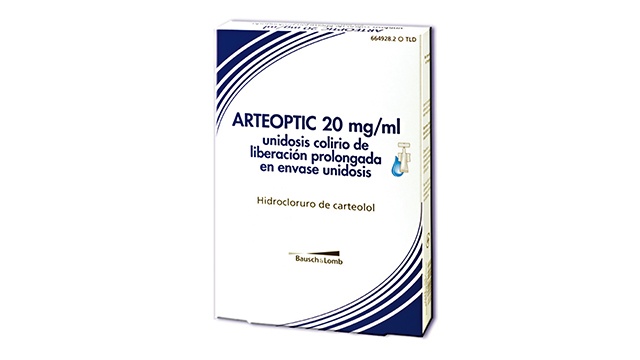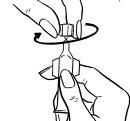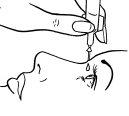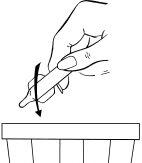

ARTEOPTIC 20 mg/ml SINGLE-DOSE PROLONGED-RELEASE EYE DROPS IN SINGLE-DOSE PACKAGING

Ask a doctor about a prescription for ARTEOPTIC 20 mg/ml SINGLE-DOSE PROLONGED-RELEASE EYE DROPS IN SINGLE-DOSE PACKAGING

How to use ARTEOPTIC 20 mg/ml SINGLE-DOSE PROLONGED-RELEASE EYE DROPS IN SINGLE-DOSE PACKAGING
Introduction
Package Leaflet: Information for the User
ARTEOPTIC 20 mg/ml single-dose eye drops of prolonged release in single-dose container
Carteolol Hydrochloride
Read the package leaflet carefully before you start using this medicine because it contains important information for you.
- Keep this package leaflet, you may need to read it again.
- If you have any further questions, ask your doctor or pharmacist.
- This medicine has been prescribed for you only. Do not pass it on to others. It may harm them, even if their signs of illness are the same as yours.
- If you get any side effects, talk to your doctor or pharmacist. This includes any possible side effects not listed in this leaflet. See section 4.
Contents of the package leaflet
- What ARTEOPTIC in single-dose container is and what it is used for
- What you need to know before you use ARTEOPTIC in single-dose container
- How to use ARTEOPTIC in single-dose container
- Possible side effects
- Storing ARTEOPTIC in single-dose container
- Contents of the pack and other information
1. What ARTEOPTIC in single-dose container is and what it is used for
ARTEOPTIC belongs to a group of medicines called beta-blockers.
It is used for the local treatment of the following eye diseases:
- Certain forms of glaucoma (chronic open-angle glaucoma)
- Increased pressure in the eyes (intraocular hypertension)
2. What you need to know before you use ARTEOPTIC in single-dose container
You must not use ARTEOPTIC in single-dose container
- If you are allergic to carteolol hydrochloride or any of the other ingredients of this medicine (listed in section 6)
- If you have or have had respiratory diseases such as asthma, severe chronic obstructive bronchitis (a serious lung disease that can cause wheezing, difficulty breathing and/or long-term coughing)
- If you have or have had heart problems such as slow heartbeat, heart failure or irregular heartbeat
- If you have bradycardia (a pulse rate of less than 45-50 beats per minute)
- If you have an untreated pheochromocytoma (excessive production of hormones that causes severe high blood pressure)
Warnings and precautions
Talk to your doctor, pharmacist or nurse before you start using ARTEOPTIC. If you have or have had:
- Coronary heart disease (symptoms that may include chest pain or weakness, fatigue or shortness of breath), heart failure, low blood pressure
- Heart rhythm disorders such as bradycardia (slow heartbeat)
- Breathing problems, asthma or chronic obstructive pulmonary disease (a lung disease that can cause wheezing, difficulty breathing and/or long-term coughing)
- Peripheral circulation disorders (Raynaud's disease or Raynaud's syndrome)
- Diabetes, as carteolol may mask the signs and symptoms of low blood sugar levels
- Diabetes may mask the signs and symptoms of low blood sugar levels (hypoglycemia)
- Carteolol may mask the signs and symptoms of hyperthyroidism
- Treated pheochromocytoma
- Psoriasis
- Corneal disease
- History of allergic reactions
- Kidney or liver disease
Tell your doctor that you are taking ARTEOPTIC before you have an anaesthetic, as carteolol may affect the action of some medicines during anaesthesia.
To check that you are not developing resistance to the therapeutic effect of this product, when using this medicine, you should be subjected to periodic ophthalmological examinations at the start of treatment and then approximately every 4 weeks. Additionally, in the case of long-term treatment, the examinations should check if treatment failure occurs (loss of efficacy of the medicine).
If you wear contact lenses: an inhibition of tear production possibly related to this class of medicines may produce a risk of intolerance in contact lens wearers.
If you suffer from severe corneal damage (the transparent layer of the front of the eye), treatment with phosphates, in very rare cases, can cause blurred vision due to calcium accumulation.
The active substance of this medicine may produce a positive result in anti-doping tests.
Children and adolescents
This eye drop must not be used in premature babies or newborns, or in children or adolescents.
Using ARTEOPTIC in single-dose container with other medicines
ARTEOPTIC may affect or be affected by other medicines when they are being used, including other eye drops for the treatment of glaucoma.
- If you are using other medicines that are applied to the eye, you must:
- Apply the other eye medicine first
- Wait 15 minutes
- Apply ARTEOPTIC last
- Your doctor may also prescribe a miotic eye drop for the treatment of certain types of glaucoma (such as closed-angle glaucoma).
- Ophthalmological monitoring is necessary if you use an adrenaline/epinephrine eye drop at the same time as ARTEOPTIC (due to the risk of pupil dilation).
- If you take oral beta-blockers at the same time, it is often necessary to adjust the dose of ARTEOPTIC.
Although the amount of beta-blocker that reaches the bloodstream after application to the eyes is low, you should consider the interactions that have been observed with oral beta-blockers:
- The use of amiodarone (used to treat heart rhythm disorders), certain calcium antagonists (used to treat high blood pressure, such as diltiazem, fingolimod, ozanimod and verapamil) or other beta-blockers (used to treat heart failure) is not recommended.
- All beta-blockers can mask certain symptoms of hypoglycaemia: palpitations and tachycardia.
- It may increase the blood level of lidocaine (administered intravenously), which would increase the risk of cardiac and neurological side effects.
When using more than one topical eye medicine, the administration of drugs should be spaced at least 15 minutes apart. Eye ointments should be administered last.
Tell your doctor if you are using or are going to use medicines to lower blood pressure, heart medicines, medicines to treat diabetes or multiple sclerosis.
Tell your doctor or pharmacist if you are using or have recently used other medicines, including those obtained without a prescription. They will carry out specific monitoring if necessary.
Pregnancy and breastfeeding
If you are pregnant or breastfeeding, think you may be pregnant or are planning to have a baby, ask your doctor or pharmacist for advice before using this medicine.
Pregnancy
Do not use ARTEOPTIC if you are pregnant unless your doctor considers it necessary.
There are no adequate data on the use of Carteolol Hydrochloride in pregnant women.
To reduce systemic absorption, see section 3.
Breastfeeding
Do not use ARTEOPTIC if you are breastfeeding. Carteolol Hydrochloride may pass into breast milk.
Beta-blockers are excreted in breast milk. However, at therapeutic doses of Carteolol Hydrochloride eye drops, it is unlikely that there will be sufficient amounts in breast milk to produce clinical symptoms of beta-blockade in infants. To reduce systemic absorption, see section 3.
Ask your doctor before taking any medicine during breastfeeding.
Driving and using machines
After applying this product to the eyes, blurred vision may occur.
Do not drive or use machines until your vision has returned to normal.
ARTEOPTIC in single-dose container contains phosphate buffer
This medicine contains 0.049 mg of phosphates per drop, which is equivalent to 1.4 mg/ml.
3. How to use ARTEOPTIC in single-dose container
This medicine must be administered in the eyes (via the ophthalmic route).
Follow the instructions for administration of this medicine exactly as indicated by your doctor. If you are in doubt, ask your doctor or pharmacist.
ARTEOPTIC contains a specific excipient that has physical properties that allow for a single administration per day.
The recommended dose is one drop in the affected eye(s) once a day, in the morning.
However, your doctor may decide to adjust the dose, especially if you are taking oral beta-blockers at the same time (see section 2 "Using other medicines").
Instructions for use
- If you wear contact lenses, you must remove them before applying ARTEOPTIC and wait 15 minutes before putting them back on.
- To correctly administer ARTEOPTIC:
- Wash your hands carefully before applying the drops.
- Before each new use, separate a single-dose container from the strip.
- Turn the end of the vial to open the single-dose container. Hold the single-dose container upside down, gently tap the body of the vial to make the solution move towards the opening.
- Avoid touching the eye or eyelid with the edge of the container.
- For treatment, gently pull down the lower eyelid and instil one drop while looking up.
- After administration, close your eye for a few seconds.
- With your eye closed, gently wipe away any excess.
- After administering ARTEOPTIC, press your finger on the corner of your eye near your nose for 2 minutes. This prevents the active substance (carteolol) from passing into the rest of the body.
- With your eyes closed, discard any excess medicine.
- Discard the single-dose container immediately after use.
- Do not use the contents of opened or started single-dose containers.
- The number of drops in a single-dose container is sufficient for the treatment of both eyes.
Separate  Turn the cap to open
Turn the cap to open  Invert the container completely
Invert the container completely  Instil in the eye
Instil in the eye  Throw away after use
Throw away after use 
- If you are using another medicine that is applied to the eye, you must:
- Apply the other eye medicine first
- Wait 15 minutes
- Apply ARTEOPTIC last
- If your doctor has prescribed ARTEOPTIC to replace another medicine, you must stop using the other eye drop at the end of a full day of treatment.
- Start treatment with ARTEOPTIC the next day, at the dosage indicated by your doctor.
- If you think the action of ARTEOPTIC is too strong or too weak, tell your doctor or pharmacist.
Do not inject or swallow.
Duration of treatment
Follow your doctor's instructions. He will tell you how long you need to use ARTEOPTIC. Do not stop treatment before.
If you use more ARTEOPTIC in single-dose container than you should:
If too many drops are administered in the eyes, rinse them with clean water.
In case of accidental oral administration of the contents of the container, certain side effects such as a hollow sensation in the head, difficulty breathing or a feeling that your pulse is slower may appear.
In case of overdose or accidental ingestion, consult your doctor or pharmacist immediately or call the Toxicology Information Service Tel. (91) 562 04 20.
If you forget to use ARTEOPTIC in single-dose container
Do not use a double dose to make up for the forgotten dose.
If you stop treatment with ARTEOPTIC in single-dose container
If you stop treatment, your intraocular pressure may increase and cause blurred vision.
Never stop treatment without consulting your doctor or pharmacist first.
If you have any other questions about the use of this medicine, ask your doctor or pharmacist.
4. Possible side effects
Like all medicines, this medicine can cause side effects, although not everybody gets them.
You can usually continue to use the eye drops, unless the effects are severe. If you are concerned, talk to your doctor or pharmacist. Do not stop using ARTEOPTIC without telling your doctor.
As with other eye medicines (topically administered ophthalmic medicines), ARTEOPTIC may be absorbed and pass into the bloodstream. This can produce the side effects that are seen with systemic beta-blockers. The frequency of side effects after topical administration to the eyes is lower than with oral or injectable medicines. The side effects listed below include adverse reactions seen with other beta-blocker eye medicines:
The frequency of the following side effects is common (may affect up to 1 in 10 people)
- Signs and symptoms of eye irritation (e.g. burning), eye pain (e.g. stinging), itching sensation, swelling, tearing, red eyes, conjunctival redness, conjunctivitis, irritation or feeling of having something in the eye (keratitis)
- Taste disturbances
The frequency of the following side effects is uncommon (may affect up to 1 in 100 people)
- Dizziness
- Muscle weakness or pain not caused by exercise (myalgia), muscle cramps
The frequency of the following side effects is rare (may affect up to 1 in 1,000 people)
- Positive antinuclear antibody results
In very rare cases, some patients with severe damage to the transparent layer of the front of the eye (cornea) have developed corneal opacification due to calcium deposits during treatment.
The frequency of the following side effects is unknown (the frequency cannot be estimated from the available data)
- Allergic reactions including sudden swelling of the face, lips, mouth, tongue or throat that can cause breathing or swallowing problems, rash, localised and generalised rash, itching, life-threatening allergic reaction that occurs suddenly
- Low blood sugar levels
- Difficulty sleeping (insomnia), depression, nightmares, decreased libido
- Fainting, heart attack, decreased blood flow in some parts of the brain, worsening of myasthenia gravis symptoms (muscle disorder), tingling or numbness of the hands and feet, tingling, headache, memory loss
- Swollen eyelids (blepharitis), blurred vision, decreased corneal sensitivity after eye surgery (choroidal detachment after filtration surgery), decreased corneal sensitivity, dry eyes, damage to the front layer of the eyeball (corneal erosion), drooping of the upper or lower eyelid, double vision, changes in refraction (sometimes due to withdrawal of miotic eye drop treatment)
- Slow heartbeat, palpitations, changes in heart rhythm or rate, heart disease with difficulty breathing and swelling of the feet and legs due to fluid accumulation (congestive heart failure), heart condition (atrioventricular block), heart attack, heart failure
- Low blood pressure, Raynaud's phenomenon, cold hands and feet, cramps and/or leg pain when walking (claudication)
- Bronchospasm (difficulty breathing or wheezing - predominantly in patients with pre-existing bronchospastic disease), shortness of breath (dyspnoea), cough
- Nausea, indigestion, diarrhoea, dry mouth, abdominal pain, vomiting
- Hair loss, skin rash with a silvery white appearance (psoriasiform rash) or worsening of psoriasis, skin eruptions
- Systemic lupus erythematosus
- Sexual dysfunction, impotence
- Unusual muscle weakness or pain not caused by exercise (asthenia) or fatigue, chest pain, fluid accumulation (oedema)
Reporting of side effects:
If you experience any side effects, talk to your doctor, pharmacist or nurse, even if they are not listed in this leaflet. You can also report them directly through the Spanish Medicines Monitoring System for Human Use: https://www.noficaram.es. By reporting side effects, you can help provide more information on the safety of this medicine.
5. Storing ARTEOPTIC in single-dose container
- Keep this medicine out of the sight and reach of children.
- Do not use this medicine after the expiry date which is stated on the container after “EXP” (expiry date). The expiry date is the last day of the month indicated.
- Do not store above 25°C.
- It must be discarded after 28 days of the first opening of the bottle.
- Do not use if the closure is damaged.
Medicines should not be disposed of via wastewater or household waste. Dispose of the containers and medicines you no longer need in the SIGRE collection point at the pharmacy. If you are in doubt, ask your pharmacist how to dispose of the containers and medicines you no longer need. This will help protect the environment.
6. Container contents and additional information
Composition of ARTEOPTIC 2% prolonged-release eye drops in single-dose container
- The active ingredient is:carteolol hydrochloride.
ARTEOPTIC 20 mg/ml: each ml of eye drops contains 20 mg of carteolol hydrochloride or each single-dose container (0.2 ml) contains 4 mg of carteolol hydrochloride.
- The other components are:sodium dihydrogen phosphate dihydrate, disodium phosphate dodecahydrate, sodium chloride, alginic acid, sodium hydroxide (for pH adjustment) and purified water.
Appearance of the product and container contents
This medication is an ocular beta-blocker.
ARTEOPTIC 20 mg/ml prolonged-release eye drops are presented as a transparent, slightly yellow-brown solution packaged in strips of 0.2 ml single-dose containers and packaged in a pouch (polyester/aluminum/polyethylene).
Container of 30 single-dose containers.
Only some package sizes may be marketed.
Marketing authorization holder and manufacturer
Marketing authorization holder:
BAUSCH + LOMB IRELAND LIMITED
3013 Lake Drive
Citywest Business Campus
Dublin 24, D24PPT3
Ireland
Manufacturer:
Laboratoire CHAUVIN
Zone Industrielle Ripotier Haut - 07200 Aubenas
France
Local representative:
Bausch&Lomb S.A.
Avda. Valdelaparra nº4
28108 Alcobendas (Madrid)
This medication is authorized in the Member States of the European Economic Area under the following names:
France: Carteol L.P 1% and Carteol L.P 2% collyres à libération prolongée en récipient unidose
Portugal: Physioglau 1% and Physioglau 2% colírio de libertação prolongada, recipiente para dose única.
Italy: Fortinol 1% & 2% monodose, collirio a rilascio prolungato, contenitore monodose.
Spain: ARTEOPTIC 20 mg/ml, colirio de liberación prolongada, envases unidosis.
Date of the last revision of this prospectus:February 2023
Detailed and updated information on this medication is available on the website of the Spanish Agency for Medicines and Health Products (AEMPS) http://www.aemps.gob.es/

How much does ARTEOPTIC 20 mg/ml SINGLE-DOSE PROLONGED-RELEASE EYE DROPS IN SINGLE-DOSE PACKAGING cost in Spain ( 2026)?
The average price of ARTEOPTIC 20 mg/ml SINGLE-DOSE PROLONGED-RELEASE EYE DROPS IN SINGLE-DOSE PACKAGING in January, 2026 is around 3.81 EUR. Prices may vary depending on the region, pharmacy, and whether a prescription is required. Always check with a local pharmacy or online source for the most accurate information.
- Country of registration
- Average pharmacy price3.81 EUR
- Availability in pharmaciesSupply issue reported
- Active substance
- Prescription requiredYes
- Manufacturer
- This information is for reference only and does not constitute medical advice. Always consult a licensed doctor before taking any medication. Oladoctor is not responsible for medical decisions based on this content.
- Alternatives to ARTEOPTIC 20 mg/ml SINGLE-DOSE PROLONGED-RELEASE EYE DROPS IN SINGLE-DOSE PACKAGINGDosage form: PROLONGED-RELEASE EYE DROP, 10 mg carteolol hydrochloride/mlActive substance: carteololManufacturer: Bausch + Lomb Ireland LimitedPrescription requiredDosage form: PROLONGED-RELEASE EYE DROP, 20 MG/MLActive substance: carteololManufacturer: Bausch + Lomb Ireland LimitedPrescription requiredDosage form: NULL, 20 mg/mlActive substance: carteololManufacturer: Bausch + Lomb Ireland LimitedPrescription required
Alternatives to ARTEOPTIC 20 mg/ml SINGLE-DOSE PROLONGED-RELEASE EYE DROPS IN SINGLE-DOSE PACKAGING in other countries
The best alternatives with the same active ingredient and therapeutic effect.
Alternative to ARTEOPTIC 20 mg/ml SINGLE-DOSE PROLONGED-RELEASE EYE DROPS IN SINGLE-DOSE PACKAGING in Poland
Online doctors for ARTEOPTIC 20 mg/ml SINGLE-DOSE PROLONGED-RELEASE EYE DROPS IN SINGLE-DOSE PACKAGING
Discuss dosage, side effects, interactions, contraindications, and prescription renewal for ARTEOPTIC 20 mg/ml SINGLE-DOSE PROLONGED-RELEASE EYE DROPS IN SINGLE-DOSE PACKAGING – subject to medical assessment and local rules.














